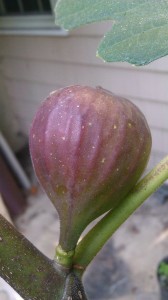 On a fig tree the Main crop of fruit is produced on the current year’s growth which is green wood and the fruit embryo’s growth from above between the leaf and the stem/branch.
On a fig tree the Main crop of fruit is produced on the current year’s growth which is green wood and the fruit embryo’s growth from above between the leaf and the stem/branch.
The Breba crop is produced on the prior year’s wood growth and this grows on hardened wood (brown and lignified) and thus has no leaves. The Breba crop occurs (if the embryos persist) first and then the main crop grows.
 Not all fig varieties produce Breba crop and some fig tree which require pollination from a wasp (not in our neck of the woods) will not ripen their main crop of fruit. For the sake of this write up we are only concerned with common fig varieties that produce fruit without a wasp or other pollination methods.
Not all fig varieties produce Breba crop and some fig tree which require pollination from a wasp (not in our neck of the woods) will not ripen their main crop of fruit. For the sake of this write up we are only concerned with common fig varieties that produce fruit without a wasp or other pollination methods.
The Breba crop is often less plentiful yet larger in size than the main crop of figs. Some say the breba crop is less flavorful but i find this only to be true if there has been consistent rain during ripening and the fruit is bloated and the sugars have not developed sufficiently.
It takes 90-100 days for fruit to ripen from the onset of embryo visibility. Based upon your USDA range and the weather you can estimate when the fruit will ripen. In zone 7 here in Southwest CT I know its usually cool outside by Halloween. Based upon that I know that any fruit that begins to emerge after August will not ripen so I remove any of this fruit. This allows the tree to puts its energy into the remaining figs and helps insure that they will ripen. I also stop fertilizing after August also as I want the plant to reduce vegetive growth (branches and leaves) and put its energy into the fruit.
 Keep in mind that with potted fig trees you are Mother Nature and you can control the nutrient uptake and watering schedule of the plant. In potted fig tree you do actually fertilize it more than an in ground fig tree due to the fact that your watering/rain washes away need nutrients.
Keep in mind that with potted fig trees you are Mother Nature and you can control the nutrient uptake and watering schedule of the plant. In potted fig tree you do actually fertilize it more than an in ground fig tree due to the fact that your watering/rain washes away need nutrients.
Hope this helps and good luck!